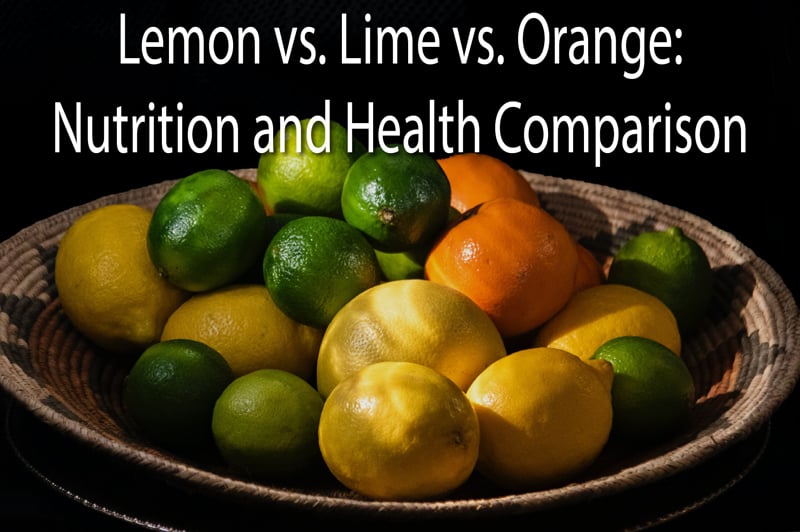Summary
Lemons and limes have a higher amount of fiber than oranges. Oranges have more vitamins and less sodium, while lemons are lower in carbs and calories. In contrast, limes are higher in minerals and lower in fat and glycemic index.
Introduction
Lemons, limes, and oranges are the most common citrus fruits worldwide. We’ll dig deeper into the key differences in these fruits’ nutrition and health benefits.
What’s The Actual Difference?
On the outside, oranges, lemons, and limes are easy to differentiate; lemons are yellow and oval, oranges are orange, yellow-orange, or red-orange and limes are green and round. Limes are typically smaller in size than lemons and oranges.
Lemons are sweeter, whereas limes are bitter or sour. You can visit the “Lemon vs. Lime” page for a complete comparison.
All of these citrus fruits are typically consumed raw, but they can also be used in cooking, cocktails, and dishes.
They are all hybrid citrus fruits from the Rutaceae family and the Citrus genus. According to a genomic study [1], oranges are a cross between pomelo and mandarin. On the other hand, lemons are a hybrid of sour orange and citron, and limes are hybrids of citron, mandarin orange, pomelo, and, most notably, wide lime varieties.
Nutrition
Lemons and limes have similar nutritional profiles, while orange’s nutrition profile is slightly different, as it hasmore vitamins.
Vitamins and Minerals
In comparison, oranges have higher vitamin content. They have more Vitamin B1, Vitamin B2, Vitamin B3, Vitamin B3, Vitamin B5, and folate, and less sodium than limes and lemons.
On the other hand, lime contains a higher amount of Vitamin E and Vitamin K, and lemon is higher in Vitamin B6.
Oranges also have more calcium, magnesium, potassium, and less sodium, whereas limes are higher inphosphorus, zinc, iron, and copper.
Oranges and lemons have an equal amount of Vitamin C: 53mg per 100g, falling in the range of the top 12% of foods as Vitamin C sources.
Micronutrients
The number of orange carbs is higher than that of lemon and lime. Similarly, oranges also have a higher net carb content: 9.3g g per 100g.
Lemon and lime have an equal amount of fiber: 2.8g per 100g, whereas orange has 2.4g fiber. All three fruits have similar amounts of protein.
Oranges have almost two times more calories than lemon and lime; however, all three fruits are considered low-calorie food.
All three fruits have tiny amounts of fat and no cholesterol.
Glycemic Index
According to the International Tables of Glycemic Index, the glycemic index of fruit differs depending on the country it was grown in. However, lime’s glycemic index is calculated at 32, while the GI of lemon has not yet been measured.
Orange’s glycemic index is equal to 45.
Health Impact
Diabetes
Lemon juice has been shown in studies to slow the digestion of carbohydrates to sugar. The acidity of lemon juice causes this effect, which slows starch digestion. In one study [2], patients were given a three-day lemonand lime diet. The urine was collected, the glucose was analyzed daily, and the amount of glycemia. The study indicates that this treatment relieves specific symptoms, such as diabetes-related glucose levels.
Oranges help to regulate blood sugar levels because they contain more fiber. According to one study [3], people who consumed oranges and citrus fruits were 36% less likely to be diagnosed with type 2 diabetes than those who did not consume enough of them.
Cancer
Citrus fruits contain phytoene, phytofluene, and other xanthophyll groups like monohydroxy carotenoids, all of which have been linked to a lower risk of cancer, especially in the digestive and upper respiratory tracts [4].
Oranges have the highest Vitamin C content among the three fruits, making them a powerful antioxidant that can aid in the fight against oxidative stress and free radicals. According to one study [5], Vitamin C has anti-cancer properties against colon, pancreatic, and breast cancers.
Cardiovascular Health
While all three fruits are high in flavanones, oranges have a higher concentration than lemons and limes. Citrus fruits contain high flavonoids linked to lower cardiovascular mortality and morbidity [6]. One study shows [7] that citrus fruit flavonoids significantly reduce the risk of cardiovascular disease, including myocardial infarction, dyslipidemia, and coronary artery pathology.
Weight Loss Diets
Oranges, lemons, and limes can be used in diets for weight loss and healthy eating. All three fruits are suitable for low-fat and low-calorie diets, such as the Dukan (Consolidation Phase) [8].
These fruits are also suitable for the Mediterranean, Paleo, Vegan/ Vegetarian/ Pescetarian, and Gluten-free diets. Furthermore, because these fruits are high in antioxidants and phenolic compounds, they are ideal for anti-inflammatory diets.
According to one study, a lemon detox program consisting of organic maple and palm syrups mixed with lemon juice and followed for seven days reduces body fat and insulin resistance without causing hematological changes [9].
References
- https://www.nature.com/articles/nbt.2906
- https://link.springer.com/article/10.1007/s00394-020-02228-x
- https://www.ncbi.nlm.nih.gov/pmc/articles/PMC8475213/
- https://www.researchgate.net/publication/286122827
- https://pubmed.ncbi.nlm.nih.gov/23117440/
- https://pubmed.ncbi.nlm.nih.gov/17344514/
- https://pubmed.ncbi.nlm.nih.gov/21425871/
- https://pubmed.ncbi.nlm.nih.gov/20679559/
- https://pubmed.ncbi.nlm.nih.gov/25912765/
Advertising disclosure: We may receive compensation for some of the links in our stories. Thank you for supporting LA Weekly and our advertisers.


